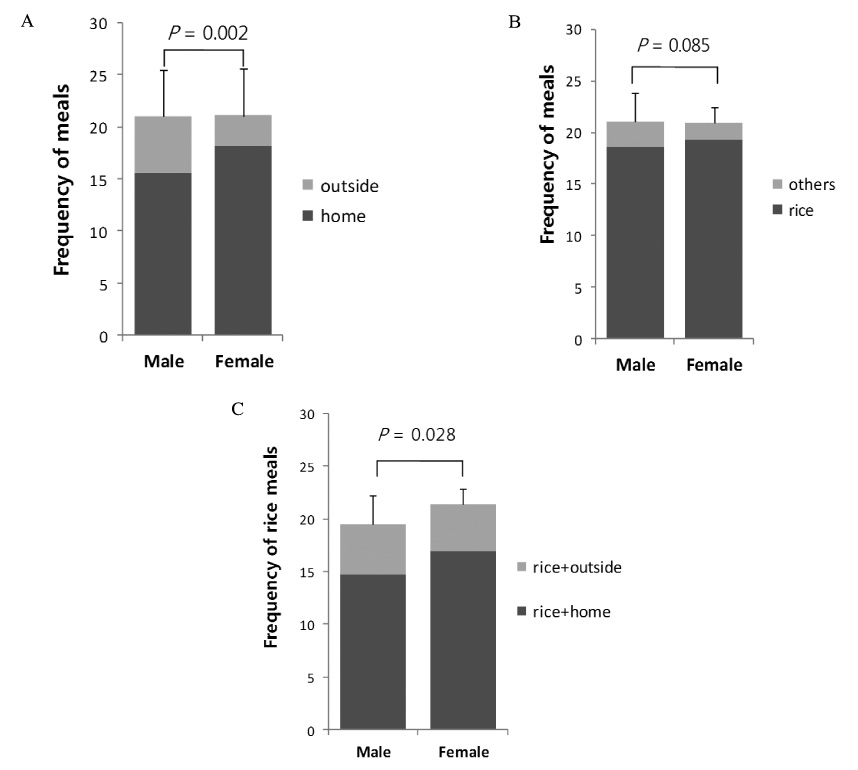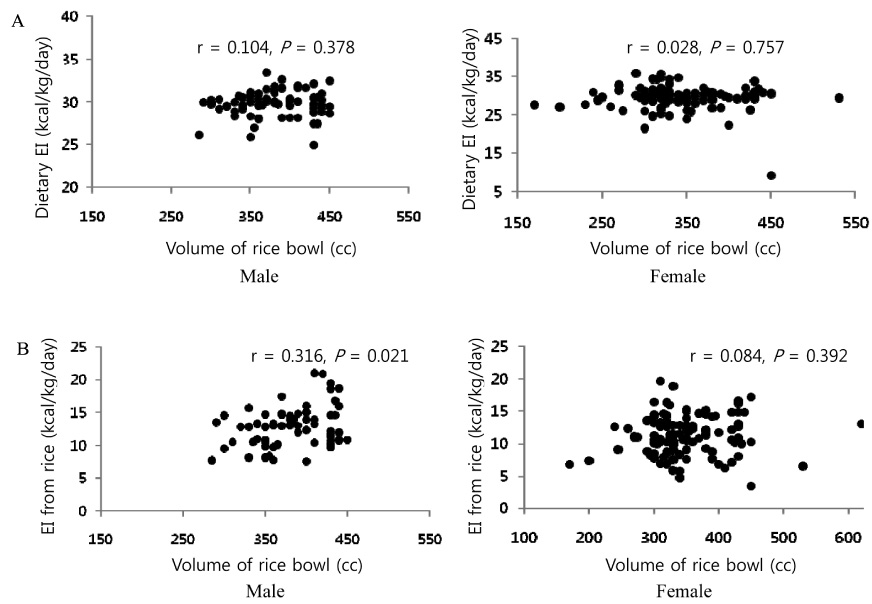Korean Diabetes J.
2009 Aug;33(4):335-343. 10.4093/kdj.2009.33.4.335.
Association Between Volume of Bowls and the Dietary Intakes in Subjects with Type 2 Diabetes
- Affiliations
-
- 1Diabetes Center, Eulji Hospital, Seoul, Korea.
- 2Department of Internal Medicine, Seoul National University School of Medicine, Seoul, Korea.
- 3Department of Internal Medicine, Eulji University School of Medicine, Daejeon, Korea. minyungwa@yahoo.co.kr
- KMID: 2222411
- DOI: http://doi.org/10.4093/kdj.2009.33.4.335
Abstract
- BACKGROUND
The results of previous studies suggest that portion size is a major factor dictating dietary energy intake. We investigated the relationship between frequencies of rice meals, bowl volumes, and dietary energy intake in a sample of patients with type 2 diabetes. METHODS: A total of 203 type 2 diabetes patients were enrolled in the study. A one-week food diary was collected from each patient and used to assess the types of meal consumed as well as the context of consumption. The volumes of the eating vessels (rice, soup and side dish bowls) used by each patient were obtained by comparisons to measuring cylinders, and dietary energy and macronutrient intake were estimated for each patient by consulting three-day dietary records. RESULTS: The mean age of the 203 subjects (male: 76, female: 127) was 53.9 +/- 9.1 years and the average body mass index (BMI) was 25.6 +/- 4.2 kg/m2. Among the subjects who ate three times per day, 96.4% consumed rice more than twice out of three meals. The median volume of rice bowls used by patients was 350 cc, of soup bowls was 530 cc and of side dish bowls was 260 cc. Portion size, as estimated by rice bowl volume, was not associated with BMI. Male subjects tended to eat out of larger rice and soup bowls (P < 0.001). Portion size was correlated with energy intake from rice (P = 0.021), but not with total energy intake (kcal/kg/day), especially in male subjects. CONCLUSION: Portion size of rice bowl was correlated with energy intake from rice, but not with total energy intake in male subjects with type 2 diabetes. To design effective meal planning methods for patients with type 2 diabetes, further prospective studies are warranted to investigate causative relationships between portion size andmetabolic conditions as well as variation by gender.
MeSH Terms
Figure
Cited by 2 articles
-
Nutrients and Dish Intake by Fasting Blood Glucose Level
Jihyun Choi, Hyun-Kyung Moon
Korean J Nutr. 2010;43(5):463-474. doi: 10.4163/kjn.2010.43.5.463.Trends in adherence to dietary recommendations among Korean type 2 diabetes mellitus patients
Kyong Park
Nutr Res Pract. 2015;9(6):658-666. doi: 10.4162/nrp.2015.9.6.658.
Reference
-
1. Li Z, Hong K, Saltsman P, DeShields S, Bellman M, Thames G, Liu Y, Wang HJ, Elashoff R, Heber D. Long-term efficacy of soy-based meal replacements vs an individualized diet plan in obese type II dm patients: Relative effects on weight loss, metabolic parameters, and c-reactive protein. Eur J Clin Nutr. 2005. 59:411–418.2. Young LR, Nestle M. The contribution of expanding portion sizes to the US obesity epidemic. Am J Public Health. 2002. 92:246–249.3. Young LR, Nestle M. Expanding portion sizes in the US marketplace: Implications for nutrition counseling. J Am Diet Assoc. 2003. 103:231–234.4. Nielsen SJ, Popkin BM. Patterns and trends in food portion sizes, 1977-1998. JAMA. 2003. 289:450–453.5. Rolls BJ, Morris EL, Roe LS. Portion size of food affects energy intake in normal-weight and overweight men and women. Am J Clin Nutr. 2002. 76:1207–1213.6. Nurss JR, el-Kebbi IM, Gallina DL, Ziemer DC, Musey VC, Lewis S, Liao Q, Phillips LS. Diabetes in urban African Americans: Functional health literacy of municipal hospital outpatients with diabetes. Diabetes Educ. 1997. 23:563–568.7. El-Kebbi IM, Bacha GA, Ziemer DC, Musey VC, Gallina DL, Dunbar V, Phillips LS. Diabetes in urban African Americans. V. Use of discussion groups to identify barriers to dietary therapy among low-income individuals with non-insulin-dependent diabetes mellitus. Diabetes Educ. 1996. 22:488–492.8. Hebert JR, Ma Y, Clemow L, Ockene IS, Saperia G, Stanek EJ 3rd, Merriam PA, Ockene JK. Gender differences in social desirability and social approval bias in dietary self-report. Am J Epidemiol. 1997. 146:1046–1055.9. Sevick MA, Napolitano MA, Papandonatos GD, Gordon AJ, Reiser LM, Marcus BH. Cost-effectiveness of alternative approaches for motivating activity in sedentary adults: Results of project stride. Prev Med. 2007. 45:54–61.10. Moore JK, Elliott RA, Payne K, Moore EW, St Leger AS, Harper NJ, Pollard BJ, Kerr J. The effect of anaesthetic agents on induction, recovery and patient preferences in adult day case surgery: A 7-day follow-up randomized controlled trial. Eur J Anaesthesiol. 2008. 25:876–883.11. Korean Diabetes Association. A guideline for diabetes education. 2006. 2th ed. Seoul: Gold agency;167.12. Zappitelli M, Goldstein SL, Symons JM, Somers MJ, Baum MA, Brophy PD, Blowey D, Fortenberry JD, Chua AN, Flores FX, Benfield MR, Alexander SR, Askenazi D, Hackbarth R, Bunchman TE. Prospective Pediatric Continuous Renal Replacement Therapy Registry Group. Prospective Pediatric Continuous Renal Replacement Therapy Registry Group: Protein and calorie prescription for children and young adults receiving continuous renal replacement therapy: a report from the Prospective Pediatric Continuous Renal Replacement Therapy Registry Group. Crit Care Med. 2008. 36:3239–3245.13. Ministry of Health and Welfare. The Korean national health nutrition examination survey 2005. 2007. Seoul: Korean Ministry of Health and Welfare.14. Cho YY, Lee MK, Jang HC, Rha MY, Kim JY, Park YM, Sohn CM. The clinical and cost effectiveness of medical nutrition therapy for patients with type 2 diabetes mellitus. Korean J Nutr. 2008. 41:147–155.15. Moon HK, Kim EG. Food intake patterns of Koreans by the economic status using 1998 Korean national health examination nutrition survey. Korean J Nutr. 2004. 37:316–328.16. Song YJ, Jeoung HJ, Paik HY. Socioeconomic nutrient and health risk factors associated with dietary patterns in adult populations from 2001 Korean national health and nutrition 2001. Korean J Nutr. 2005. 38:219–225.17. Choi JH, Moon HK. Comparison of dietary patterns by sex and urbanization in different economic status. Korean J community Nutr. 2008. 13:346–358.18. Choi JH, Moon HK. Dietary pattern by sex and age with menu analysis using 1998, 2001 national health and nutrition survey of Korea. Korean J Community Nutr. 2007. 12:798–814.19. Eck LH, Klesges LM, Klesges RC. Precision and estimated accuracy of two short-term food frequency questionnaires compared with recalls and records. J Clin Epidemiol. 1996. 49:1195–1200.20. Korea centers for disease control and prevents. 2007 national health statistics. 2008. Seoul: Korea centers for disease control and prevents.21. Chang UJ, Jung EY, Hong IS. The effect of the reduced portion size by using a diet rice bowl on food consumption and satiety rate. Korean J Community Nutr. 2007. 12:639–645.22. Son SM. Rice based meal for prevention of obesity and chronic disease. Korean J Community Nutrition. 2001. 6:862–867.23. Oh SY. Food sharing characteristics in modern Korean society. Korean J Food Culture. 2005. 20:683–687.24. Moon HK, Lee SS, Lee JS, Park SY, Han GJ, Yu CH, Paik HY, Jung GJ. The study of menu patterns in Korean rural areas (2) - compared by the area. Korean J Nutr. 2002. 35:658–667.25. Wansink B. Environmental factors that increase the food intake and consumption volume of unknowing consumers. Annu Rev Nutr. 2004. 24:455–479.26. Diliberti N, Bordi PL, Conklin MT, Roe LS, Rolls BJ. Increased portion size leads to increased energy intake in a restaurant meal. Obesity. 2004. 12:562–568.27. Ledikwe JH, Ello-Martin JA, Rolls BJ. Portion sizes and the obesity epidemic. J Nutr. 2005. 135:905–909.28. Rolls BJ, Roe LS, Meengs JS. The effect of large portion sizes on energy intake is sustained for 11 days. Obesity. 2007. 15:1535–1543.29. Pedersen SD, Kang J, Kline GA. Portion control plate for weight loss in obese patients with type 2 diabetes mellitus: a controlled clinical trial. Arch Intern Med. 2007. 167:1277–1283.
- Full Text Links
- Actions
-
Cited
- CITED
-
- Close
- Share
- Similar articles
-
- Comparative Analysis of the Intake Volume, Perception Volume, and Satiety Rate of an Augmented Rice Bowl with an Elevated Bottom
- Dietary Sodium Intake in Patients with Type 2 Diabetes Mellitus
- The Effects of Small Sized Rice Bowl on Carbohydrate Intake and Dietary Patterns in Women with Type 2 Diabetes
- Ratio of fat to energy intake independently associated with the duration of diabetes and total cholesterol levels in type 2 diabetes
- Adiponectin gene SNP 276G --> T, nutrient intakes, and cardiovascular disease risk in Korean type 2 DM patients



